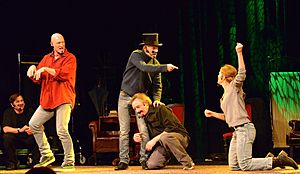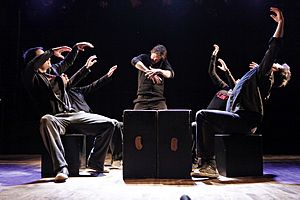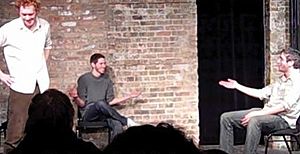Improvisational theatre facts for kids
Improvisational theatre, often called improv, is a type of theatre where most or all of what is performed is made up on the spot. It's not planned or written down beforehand. In its purest form, the talking, actions, story, and characters are all created together by the performers as the show happens. They don't use a script that was prepared earlier.
Improv can be many different styles, from funny comedy shows to serious plays. Sometimes, it's even used in movies and TV. It helps actors develop characters and stories. It can also be part of the final show.
Improv techniques are often used in drama classes. They help train actors for the stage, movies, and TV. Improv is also a big part of how actors practice for a show. But the skills from improv are useful outside of acting too. This is called applied improvisation. It's used in classrooms to help kids learn. Businesses use it to improve communication skills. It also helps people solve problems creatively and work better in teams. Sometimes, it's even used in psychotherapy. It helps people understand their thoughts, feelings, and relationships.
Contents
History of Improv
The first known use of improv in Western history was in ancient Rome. It was called Atellan Farce around 391 BC. Later, from the 1500s to the 1700s, commedia dell'arte performers in Italy made up their shows. They used a basic story outline. In the late 1800s, theatre experts like Konstantin Stanislavski from Russia and Jacques Copeau from France started using improv a lot. They used it to train actors and during rehearsals.
Modern Improv Begins
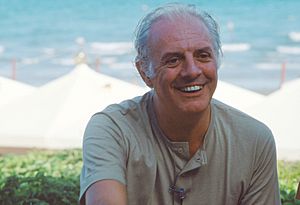
Modern improv games started as exercises for children. They were a key part of drama education in the early 1900s. This was thanks to the progressive education movement. John Dewey started this movement in 1916. Some people say Dudley Riggs was the first vaudeville performer to use audience ideas. He created improv sketches on stage.
Viola Spolin developed improv exercises even more in the 1940s, 50s, and 60s. She wrote Improvisation For The Theater. This was the first book to give specific ways to learn and teach improv. In 1977, Clive Barker's book Theatre Games helped spread improv ideas worldwide. British writer and director Keith Johnstone wrote Impro: Improvisation and the Theatre. This book shared his ideas on improv. He also invented Theatresports. This became a very popular type of improv comedy. It even inspired the TV show Whose Line Is It Anyway?
Viola Spolin taught the first modern American improvisers. They were at The Compass Players in Chicago. This group later led to The Second City. Her son, Paul Sills, and David Shepherd started The Compass Players. After The Compass Players ended, Paul Sills began The Second City. These were the first organized improv groups in Chicago. The modern Chicago improv comedy scene grew from their success.
Many of the current "rules" for comedy improv were first made in Chicago. This happened in the late 1950s and early 1960s. It started with The Compass Players group, led by Paul Sills. When The Second City opened in 1959, Viola Spolin began training new improvisers. She used classes and exercises. These became the foundation of modern improv training. Many famous comedians started at The Second City. This includes people like Mike Myers, Tina Fey, Stephen Colbert, and Steve Carell.
At the same time, Keith Johnstone's group, The Theatre Machine, toured Europe. This group started Theatresports. It began in Johnstone's workshops. Later, it became public when he moved to Canada. Toronto has a strong improv tradition.
In 1984, Dick Chudnow started ComedySportz in Milwaukee, WI. It grew to many cities. Now, it's called CSz Worldwide. It has 29 teams in different countries.
In San Francisco, The Committee theatre was active in the 1960s. It was started by people from Chicago's Second City.
Some early political improv came from Jerzy Grotowski in Poland in the 1950s. Also, Augusto Boal's "Forum Theatre" in South America in the 1970s. These works led to pure improv shows. Others just added to theatre ideas.
Joan Littlewood, an English actress and director, used improv a lot. She developed plays using it. But she was charged twice for letting actors improvise during shows. Before 1968, British law said scripts had to be approved. Inspectors checked that the approved script was followed exactly.
In 1987, Annoyance Theatre started in Chicago. It focuses on longform improv. It has grown to multiple locations. It's home to the longest-running musical improv show, which ran for 11 years.
In 2012, Lucien Bourjeily used improv to create a play called 66 Minutes in Damascus. It was very interactive. The audience played kidnapped tourists in Syria.
Rob Wittig and Mark C. Marino created netprov. This is improv for online theatre. It uses social media to involve audiences. They create stories that change in real-time.
Improv Comedy Styles
Modern improv comedy usually comes in two main types: shortform and longform.
Shortform improv has short scenes. They are usually based on a specific game, structure, or idea. An audience suggestion often drives them. Many shortform exercises were created by Viola Spolin. She called them theatre games. The TV show Whose Line Is It Anyway? made shortform improv popular in America and Britain.
Longform improv performers create shows where short scenes are connected. They might be linked by story, characters, or themes. Longform shows can be like a full play or a Broadway-style musical. One famous longform structure is the Harold. Del Close, who co-founded ImprovOlympic, developed it. Many actors like Will Ferrell, Tina Fey, and Steve Carrell started with longform improv.
Longform improv is very popular in many cities. These include Chicago, New York City, and Los Angeles. It's also growing in the United Kingdom, especially in London.
Other Types of Improv Theatre
Not all improv is meant to be funny. Some forms are more experimental or dramatic. These include Playback Theatre and Theatre of the Oppressed.
The Open Theatre was started in New York City. It explored political, artistic, and social topics. This group used improv from Viola Spolin. They created exercises like "sound and movement." They also developed new theatre forms. They could create full shows with just actors, chairs, and a bare stage. They used improv to build characters, time, and place.
On the West Coast, Ruth Zaporah created Action Theater™. This is a physical improv form. It treats language, movement, and voice equally. Action Theater™ shows have no scripts. They create full-length performances on the spot. Dramatic and story-based improv is strong on the West Coast. Groups like San Francisco's BATS Improv create full plays and musicals through improv.
Improv Principles in Daily Life
Many people who study improv find its ideas helpful in everyday life. Not just on stage.
Tina Fey, in her book Bossypants, shares improv rules for the workplace. There's a lot of interest in using improv lessons in business. A New York Times article asked, "Can Executives Learn to Ignore the Script?" Patricia Ryan Madson, a Stanford professor, said people are looking for ways to be more creative. Improv helps them say "yes" to their own ideas.
Using improv ideas is also common for helping teams come up with new ideas.
Improv in Film and TV
Many directors have used improv in movies and TV shows. This includes both popular and experimental films. Early silent filmmakers like Charlie Chaplin and Buster Keaton used improv. They made up jokes while filming. The Marx Brothers were known for changing their scripts. Their made-up lines often became part of their films.
British director Mike Leigh uses improv a lot in his films. He even has actors improvise important moments that won't be in the final movie. This Is Spinal Tap and other mockumentary films by Christopher Guest mix scripted and unscripted parts.
Famous American directors who used improv with actors include John Cassavetes and Robert Altman.
Improv comedy techniques have been used in popular TV shows. These include HBO's Curb Your Enthusiasm and Whose Line Is It Anyway. Other shows like Wild 'N Out and Thank God You're Here also use improv. An early American improv TV show was What Happens Now? in 1949. The Canadian show Train 48 was improvised from basic outlines. Reno 911! also had improvised talking.
Improv and Psychology
In psychology, some experts have looked at how actors and improvisers feel. They believe actors often enter a special state of mind. Improv can change how people pay attention, imagine things, and express feelings.
In Drama Therapy, improv is used a lot. The ""Yes, and" rule from improv has been compared to therapy methods. Improv training has been suggested for couples therapy. It may also help people with social anxiety disorder.
How Improv Works
Improv theatre often involves the audience. Improv groups often ask for ideas from the audience. This helps them get inspiration. It also shows that the performance is not planned. Sometimes, improv can look so good that people think it must be scripted!
For an improvised scene to work, the improvisers must work together. They define the scene's details and actions. This is called co-creation. With every word or action, an improviser makes an offer. This means they add something to the scene's reality. They might give a character a name. They could define a relationship or a place. They might use mime to show objects or the environment.
Other improvisers must accept these offers. If they don't, it's called blocking or denial. This usually stops the scene from moving forward. Sometimes, performers might block for a funny effect. But this often prevents the scene from growing. Accepting an offer usually means adding a new offer. This builds on the earlier one. This process is called Yes, and.... It's a key part of improv. Every new piece of information helps the improvisers. It helps them build their characters and move the scene along. The Yes, and... rule is most important at the start of a scene. It helps create a shared reality. Then, improvisers can build on it for comedy.
Improv doesn't have a script. So, there's no planned knowledge about props. Improv groups might have some props ready. But many improvisers prefer to use mime. This is called 'space object work' or 'space work' in improv. It creates props and places using imagination. Improvisers should respect the imaginary environment. For example, they shouldn't walk through a pretend table.
Improvisers often play many different roles without practice. They need to create characters quickly. They use their body, gestures, accents, and voice changes. An improviser might play someone of a different age or gender. What a character wants is important in improv scenes. Improvisers try to act based on their character's goals.
In improv shows with many scenes, a signal is used to change scenes. Often, a performer runs across the stage. This is called a "wipe." Performers not in the scene usually stand at the side. They enter or leave the scene by stepping onto or off the stage.
Improv Community
Many theatre groups focus on improv shows. They also help the improv community grow through their training centers.
Besides professional groups, many colleges have improv groups. These are found in the United States and worldwide.
Important Improv People
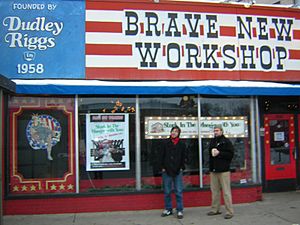
The Brave New Workshop Comedy Theater (BNW) is an improv theatre in Minneapolis, Minnesota. Dudley Riggs started it in 1958. It has been performing live comedy and improv for over 60 years. Famous people from BNW include Louie Anderson and Al Franken.
Some key people in improv are Viola Spolin and her son Paul Sills. Paul Sills founded Chicago's famous Second City group. He also created Theater Games. Del Close co-founded ImprovOlympic and created The Harold, a popular longform improv format. Keith Johnstone is a British teacher and writer. He wrote Impro and founded the Theatre Machine. His teachings are the basis of Theatresports. Dick Chudnow founded ComedySportz.
David Shepherd, with Paul Sills, started The Compass Players in Chicago. Shepherd wanted to create a "people's Theatre." Many Compass members also helped start The Second City. In the 1970s, David Shepherd and Howard Jerome created the Improvisational Olympics. This was a competition format for improv. It later became the Canadian Improv Games. In the US, Charna Halpern produced it as "ImprovOlympic," now called "IO." IO has training centers in Chicago and Los Angeles.
In 1975, Jonathan Fox founded Playback Theatre. This is a type of improv theatre that is often not funny. It re-enacts stories shared by audience members.
The Groundlings is a popular improv theatre and training center in Los Angeles. Gary Austin, its founder, taught improv across the country. He was known as a great acting teacher. The Groundlings is seen as a training ground for many improv performers.
In the late 1990s, Matt Besser, Amy Poehler, Ian Roberts, and Matt Walsh founded the Upright Citizens Brigade Theatre in New York. They later opened one in Los Angeles. Both have improv and sketch comedy schools.
Hoopla Impro started the first improv theatre in the UK and London. They also run an annual improv festival.
In 2015, The Free Association opened in London. It's similar to American improv schools.
Gunter Lösel studied different improv theories. He wrote a general theory of improv theatre.
Alan Alda's book If I Understood You, Would I Have This Look on My Face? looks at how improv helps communication in science. The book is based on his work at Alan Alda Center for Communicating Science. It shows how improv games can improve communication and understanding.
See also
 In Spanish: Improvisación teatral para niños
In Spanish: Improvisación teatral para niños
- Busking
- Guerrilla theater
- Improvisation
- List of improvisational theatre companies
- List of improvisational theater festivals
- Playback Theatre


